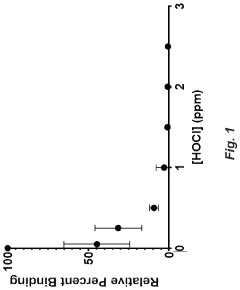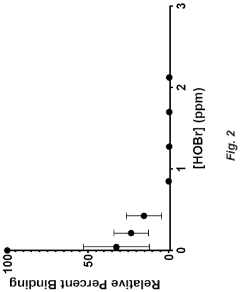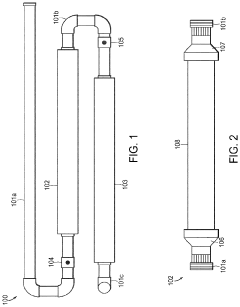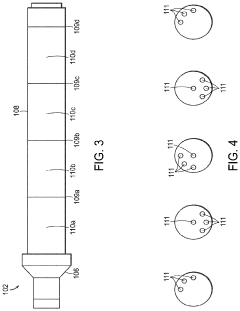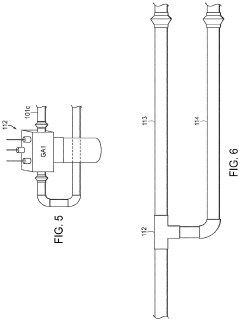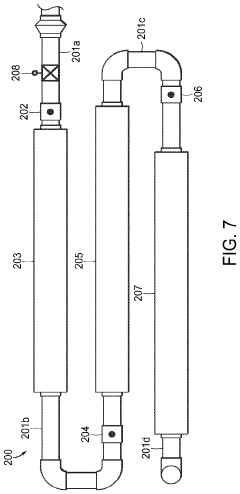Understanding Hypochlorous Acid's Biocompatibility Challenges
AUG 4, 20259 MIN READ
Generate Your Research Report Instantly with AI Agent
Patsnap Eureka helps you evaluate technical feasibility & market potential.
HOCL Biocompatibility Background and Objectives
Hypochlorous acid (HOCl) has emerged as a promising disinfectant and therapeutic agent due to its potent antimicrobial properties and potential biocompatibility. The exploration of HOCl's biocompatibility challenges is crucial for advancing its applications in healthcare and consumer products. This technical research report aims to provide a comprehensive overview of the historical development, current trends, and future objectives in understanding and addressing HOCl's biocompatibility issues.
The concept of using HOCl as a disinfectant dates back to the early 20th century when it was first recognized for its antimicrobial properties. However, the challenges associated with its stability and production limited its widespread use. In recent decades, advancements in electrochemical generation techniques have revitalized interest in HOCl, leading to a surge in research and development efforts focused on its biocompatibility.
The evolution of HOCl technology has been driven by the increasing demand for safe and effective antimicrobial solutions in various sectors, including healthcare, food processing, and water treatment. As concerns over antibiotic resistance and harmful chemical residues grow, HOCl has gained attention as a potentially safer alternative to traditional disinfectants and antiseptics.
Current research in HOCl biocompatibility focuses on several key areas. These include understanding its interactions with human tissues and cells, optimizing its concentration for maximum efficacy while minimizing adverse effects, and developing stable formulations that maintain its biocompatibility over extended periods. Additionally, researchers are investigating the potential of HOCl in wound healing, oral care, and respiratory health applications.
The primary objective of ongoing HOCl biocompatibility research is to establish a comprehensive understanding of its mechanisms of action on both microbial and human cells. This knowledge is crucial for developing guidelines for safe and effective use across various applications. Another important goal is to identify and mitigate any potential long-term effects of HOCl exposure on human health and the environment.
Looking ahead, the field aims to overcome several challenges to fully realize HOCl's potential. These include improving its stability in various formulations, developing standardized testing protocols for biocompatibility assessment, and addressing regulatory hurdles for its use in medical and consumer products. Researchers are also exploring innovative delivery systems to enhance HOCl's efficacy and biocompatibility in specific applications.
As the technology continues to evolve, interdisciplinary collaboration between chemists, biologists, materials scientists, and medical professionals will be crucial in advancing our understanding of HOCl's biocompatibility. The ultimate goal is to harness the full potential of this powerful yet gentle antimicrobial agent, paving the way for safer and more effective solutions in healthcare and beyond.
The concept of using HOCl as a disinfectant dates back to the early 20th century when it was first recognized for its antimicrobial properties. However, the challenges associated with its stability and production limited its widespread use. In recent decades, advancements in electrochemical generation techniques have revitalized interest in HOCl, leading to a surge in research and development efforts focused on its biocompatibility.
The evolution of HOCl technology has been driven by the increasing demand for safe and effective antimicrobial solutions in various sectors, including healthcare, food processing, and water treatment. As concerns over antibiotic resistance and harmful chemical residues grow, HOCl has gained attention as a potentially safer alternative to traditional disinfectants and antiseptics.
Current research in HOCl biocompatibility focuses on several key areas. These include understanding its interactions with human tissues and cells, optimizing its concentration for maximum efficacy while minimizing adverse effects, and developing stable formulations that maintain its biocompatibility over extended periods. Additionally, researchers are investigating the potential of HOCl in wound healing, oral care, and respiratory health applications.
The primary objective of ongoing HOCl biocompatibility research is to establish a comprehensive understanding of its mechanisms of action on both microbial and human cells. This knowledge is crucial for developing guidelines for safe and effective use across various applications. Another important goal is to identify and mitigate any potential long-term effects of HOCl exposure on human health and the environment.
Looking ahead, the field aims to overcome several challenges to fully realize HOCl's potential. These include improving its stability in various formulations, developing standardized testing protocols for biocompatibility assessment, and addressing regulatory hurdles for its use in medical and consumer products. Researchers are also exploring innovative delivery systems to enhance HOCl's efficacy and biocompatibility in specific applications.
As the technology continues to evolve, interdisciplinary collaboration between chemists, biologists, materials scientists, and medical professionals will be crucial in advancing our understanding of HOCl's biocompatibility. The ultimate goal is to harness the full potential of this powerful yet gentle antimicrobial agent, paving the way for safer and more effective solutions in healthcare and beyond.
Market Analysis for HOCL-Based Products
The market for hypochlorous acid (HOCl) based products has been experiencing significant growth in recent years, driven by increasing awareness of its effectiveness as a disinfectant and its potential applications in various industries. The global HOCl market is projected to expand at a compound annual growth rate of over 7% from 2021 to 2026, with the market value expected to reach several hundred million dollars by the end of the forecast period.
One of the key drivers of market demand is the growing emphasis on hygiene and sanitation, particularly in healthcare settings, food processing industries, and water treatment applications. The COVID-19 pandemic has further accelerated this trend, with heightened focus on disinfection practices across various sectors. HOCl's broad-spectrum antimicrobial properties, combined with its non-toxic and environmentally friendly nature, make it an attractive alternative to traditional chemical disinfectants.
In the healthcare sector, HOCl-based products are gaining traction for wound care, sterilization of medical equipment, and surface disinfection in hospitals and clinics. The increasing prevalence of hospital-acquired infections and the need for effective yet safe disinfection solutions are driving adoption in this segment.
The food and beverage industry represents another significant market for HOCl-based products. With stringent food safety regulations and consumer demand for clean-label products, HOCl is being increasingly used for sanitizing food processing equipment, produce washing, and extending the shelf life of perishable goods.
Water treatment is emerging as a promising application area for HOCl, with potential uses in municipal water systems, swimming pools, and industrial water treatment processes. The ability of HOCl to effectively disinfect water without producing harmful by-products positions it as a sustainable alternative to chlorine-based treatments.
Consumer products represent a growing segment of the HOCl market, with applications in household cleaning, personal care, and pet care products. The trend towards eco-friendly and non-toxic household products is driving consumer interest in HOCl-based solutions for everyday use.
Despite the positive market outlook, challenges remain in terms of product stability, shelf life, and manufacturing scalability. Addressing these technical hurdles is crucial for wider market adoption and realizing the full potential of HOCl-based products across various industries.
One of the key drivers of market demand is the growing emphasis on hygiene and sanitation, particularly in healthcare settings, food processing industries, and water treatment applications. The COVID-19 pandemic has further accelerated this trend, with heightened focus on disinfection practices across various sectors. HOCl's broad-spectrum antimicrobial properties, combined with its non-toxic and environmentally friendly nature, make it an attractive alternative to traditional chemical disinfectants.
In the healthcare sector, HOCl-based products are gaining traction for wound care, sterilization of medical equipment, and surface disinfection in hospitals and clinics. The increasing prevalence of hospital-acquired infections and the need for effective yet safe disinfection solutions are driving adoption in this segment.
The food and beverage industry represents another significant market for HOCl-based products. With stringent food safety regulations and consumer demand for clean-label products, HOCl is being increasingly used for sanitizing food processing equipment, produce washing, and extending the shelf life of perishable goods.
Water treatment is emerging as a promising application area for HOCl, with potential uses in municipal water systems, swimming pools, and industrial water treatment processes. The ability of HOCl to effectively disinfect water without producing harmful by-products positions it as a sustainable alternative to chlorine-based treatments.
Consumer products represent a growing segment of the HOCl market, with applications in household cleaning, personal care, and pet care products. The trend towards eco-friendly and non-toxic household products is driving consumer interest in HOCl-based solutions for everyday use.
Despite the positive market outlook, challenges remain in terms of product stability, shelf life, and manufacturing scalability. Addressing these technical hurdles is crucial for wider market adoption and realizing the full potential of HOCl-based products across various industries.
Current Challenges in HOCL Biocompatibility
Hypochlorous acid (HOCl) has gained significant attention in various biomedical applications due to its potent antimicrobial properties and potential for wound healing. However, its widespread adoption faces several biocompatibility challenges that need to be addressed to ensure its safe and effective use in clinical settings.
One of the primary concerns is the potential cytotoxicity of HOCl at higher concentrations. While HOCl is naturally produced by the human immune system, exogenous application at elevated levels may lead to cellular damage. This delicate balance between antimicrobial efficacy and host cell viability presents a significant challenge in developing HOCl-based therapies.
The stability of HOCl solutions is another critical issue affecting its biocompatibility. HOCl is known to be unstable and can rapidly degrade into less effective compounds, potentially forming harmful byproducts. This instability not only impacts the shelf-life of HOCl-based products but also raises concerns about its long-term effects when applied to biological tissues.
pH regulation poses a substantial challenge in HOCl biocompatibility. The antimicrobial activity of HOCl is highly pH-dependent, with optimal efficacy observed in slightly acidic conditions. However, maintaining this pH range without causing irritation or damage to surrounding tissues is a complex task, especially in dynamic biological environments.
The interaction of HOCl with various biomolecules and cellular components is not fully understood, leading to uncertainties in its overall biocompatibility profile. HOCl can react with proteins, lipids, and nucleic acids, potentially altering their structure and function. These interactions may have unintended consequences on cellular processes and tissue homeostasis.
Another significant challenge lies in the standardization of HOCl formulations for biomedical use. The varying methods of production and stabilization can result in inconsistent concentrations and purity levels, making it difficult to establish uniform safety and efficacy standards across different applications.
The potential for HOCl to disrupt the natural microbiome of the skin or wound environment is an emerging concern. While its broad-spectrum antimicrobial activity is beneficial in fighting pathogens, it may also eliminate beneficial bacteria crucial for maintaining tissue health and promoting healing.
Lastly, the long-term effects of repeated HOCl exposure on tissues and organs are not well-documented. This lack of comprehensive longitudinal studies raises questions about potential cumulative effects and the safety of prolonged use in chronic conditions or preventive applications.
Addressing these biocompatibility challenges requires a multidisciplinary approach, combining expertise in chemistry, microbiology, toxicology, and materials science. Overcoming these hurdles is crucial for unlocking the full potential of HOCl in biomedical applications and ensuring its safe integration into clinical practice.
One of the primary concerns is the potential cytotoxicity of HOCl at higher concentrations. While HOCl is naturally produced by the human immune system, exogenous application at elevated levels may lead to cellular damage. This delicate balance between antimicrobial efficacy and host cell viability presents a significant challenge in developing HOCl-based therapies.
The stability of HOCl solutions is another critical issue affecting its biocompatibility. HOCl is known to be unstable and can rapidly degrade into less effective compounds, potentially forming harmful byproducts. This instability not only impacts the shelf-life of HOCl-based products but also raises concerns about its long-term effects when applied to biological tissues.
pH regulation poses a substantial challenge in HOCl biocompatibility. The antimicrobial activity of HOCl is highly pH-dependent, with optimal efficacy observed in slightly acidic conditions. However, maintaining this pH range without causing irritation or damage to surrounding tissues is a complex task, especially in dynamic biological environments.
The interaction of HOCl with various biomolecules and cellular components is not fully understood, leading to uncertainties in its overall biocompatibility profile. HOCl can react with proteins, lipids, and nucleic acids, potentially altering their structure and function. These interactions may have unintended consequences on cellular processes and tissue homeostasis.
Another significant challenge lies in the standardization of HOCl formulations for biomedical use. The varying methods of production and stabilization can result in inconsistent concentrations and purity levels, making it difficult to establish uniform safety and efficacy standards across different applications.
The potential for HOCl to disrupt the natural microbiome of the skin or wound environment is an emerging concern. While its broad-spectrum antimicrobial activity is beneficial in fighting pathogens, it may also eliminate beneficial bacteria crucial for maintaining tissue health and promoting healing.
Lastly, the long-term effects of repeated HOCl exposure on tissues and organs are not well-documented. This lack of comprehensive longitudinal studies raises questions about potential cumulative effects and the safety of prolonged use in chronic conditions or preventive applications.
Addressing these biocompatibility challenges requires a multidisciplinary approach, combining expertise in chemistry, microbiology, toxicology, and materials science. Overcoming these hurdles is crucial for unlocking the full potential of HOCl in biomedical applications and ensuring its safe integration into clinical practice.
Existing HOCL Biocompatibility Solutions
01 Biocompatibility of hypochlorous acid in medical applications
Hypochlorous acid demonstrates biocompatibility in various medical applications due to its natural occurrence in the human body and its role in the immune system. Its use in wound care, disinfection, and sterilization processes showcases its compatibility with human tissues and cells, making it a safe and effective option for medical treatments.- Biocompatibility of hypochlorous acid in medical applications: Hypochlorous acid demonstrates high biocompatibility in various medical applications due to its similarity to naturally occurring compounds in the human body. It is effective in wound healing, disinfection, and tissue regeneration while being gentle on human cells. This makes it suitable for use in medical devices, wound care products, and topical treatments.
- Hypochlorous acid in water treatment and purification: The biocompatibility of hypochlorous acid is utilized in water treatment and purification processes. It effectively eliminates harmful microorganisms without introducing toxic byproducts, making it safe for human consumption and environmental release. This application extends to swimming pools, drinking water systems, and industrial water treatment.
- Formulation techniques to enhance hypochlorous acid stability: Various formulation techniques are employed to enhance the stability and biocompatibility of hypochlorous acid. These include pH adjustment, addition of stabilizing agents, and use of specific packaging materials. Improved stability ensures prolonged effectiveness and maintains biocompatibility over extended periods.
- Hypochlorous acid in personal care and cosmetic products: The biocompatibility of hypochlorous acid is leveraged in personal care and cosmetic products. It is used in skincare formulations, oral care products, and hygiene solutions due to its gentle yet effective antimicrobial properties. These applications benefit from its ability to maintain skin and oral microbiome balance without causing irritation.
- Environmental impact and biodegradability of hypochlorous acid: Hypochlorous acid exhibits high biocompatibility with the environment due to its rapid breakdown into harmless components. This characteristic makes it an eco-friendly alternative to traditional disinfectants and sanitizers. Its biodegradability and low toxicity to aquatic life contribute to its favorable environmental profile.
02 Hypochlorous acid in personal care and cosmetic products
The biocompatibility of hypochlorous acid extends to its use in personal care and cosmetic products. Its gentle yet effective antimicrobial properties make it suitable for skin and eye care formulations, demonstrating compatibility with sensitive tissues and minimal irritation potential.Expand Specific Solutions03 Environmental impact and biodegradability of hypochlorous acid
Hypochlorous acid exhibits favorable environmental characteristics due to its rapid breakdown into non-toxic components. This biodegradability contributes to its biocompatibility in various ecosystems, making it a preferred choice for applications where environmental impact is a concern.Expand Specific Solutions04 Hypochlorous acid in water treatment and food safety
The biocompatibility of hypochlorous acid is evident in its applications for water treatment and food safety. Its effectiveness in eliminating pathogens without leaving harmful residues demonstrates its safety for human consumption and contact, supporting its use in these critical areas.Expand Specific Solutions05 Stability and formulation of hypochlorous acid solutions
Research into the stability and formulation of hypochlorous acid solutions has enhanced its biocompatibility. Improved methods for maintaining its efficacy while ensuring safety for biological systems have expanded its potential applications in various fields, from healthcare to industrial use.Expand Specific Solutions
Key Players in HOCL Technology
The market for hypochlorous acid biocompatibility solutions is in an early growth stage, with increasing research and development efforts across academia and industry. The global market size is expanding, driven by growing applications in healthcare, water treatment, and disinfection. Technologically, the field is rapidly evolving, with companies like Industrie De Nora SpA and WIAB WATER INNOVATION AB leading commercial developments. Academic institutions such as Hunan University of Science & Technology and Cedars-Sinai Medical Center are contributing significant research. While the technology is advancing, challenges in stability, scalability, and long-term efficacy remain, indicating a moderate level of technological maturity with substantial room for innovation and improvement.
Industrie De Nora SpA
Technical Solution: Industrie De Nora SpA has developed advanced electrochemical technologies for the production of hypochlorous acid (HOCl). Their approach focuses on optimizing the electrolysis process to generate HOCl with precise control over pH and concentration. The company has implemented a membrane-based electrolytic cell design that allows for the efficient production of stable HOCl solutions[1]. This technology enables the generation of HOCl with minimal by-products, addressing biocompatibility concerns. De Nora's system incorporates real-time monitoring and adjustment of electrolysis parameters to maintain consistent HOCl quality, which is crucial for biomedical applications[2]. They have also developed specialized electrode materials that enhance the stability and purity of the produced HOCl, potentially mitigating some of the biocompatibility challenges associated with traditional production methods[3].
Strengths: Precise control over HOCl production parameters, high purity output, and scalable technology. Weaknesses: Potentially higher production costs compared to simpler methods, and the need for specialized equipment and expertise for operation and maintenance.
Cedars-Sinai Medical Center
Technical Solution: Cedars-Sinai Medical Center has conducted extensive research on the biocompatibility of hypochlorous acid, focusing on its potential medical applications. Their approach centers on understanding the interactions between HOCl and human tissues at the cellular and molecular levels[15]. The center has developed protocols for producing medical-grade HOCl with precise control over concentration and pH, which is crucial for minimizing tissue irritation and maximizing therapeutic efficacy[16]. Cedars-Sinai researchers have also investigated the effects of HOCl on wound healing and infection control, leading to the development of specialized formulations that balance antimicrobial activity with tissue compatibility[17]. Their work includes the use of advanced imaging techniques to visualize HOCl's effects on microbial biofilms and host cells, providing insights into optimizing its use in clinical settings[18]. Additionally, the center has conducted clinical trials to evaluate the safety and efficacy of HOCl-based treatments for various dermatological conditions, contributing valuable data to the understanding of its long-term biocompatibility in human subjects[19].
Strengths: Comprehensive clinical research on HOCl biocompatibility, development of medical-grade formulations, and extensive human trial data. Weaknesses: Focus primarily on medical applications may limit insights into industrial or consumer product uses of HOCl.
Breakthrough HOCL Biocompatibility Studies
Hypohalous acids for treating inflammatory diseases and inhibiting growth of malignancies
PatentInactiveUS20220202853A1
Innovation
- Development of a novel electrochemical method to produce stable, pure hypohalous acids (HOCl and HOBr) that are free from hypochlorites and hypobromites, allowing for topical and inhalation-based delivery to inactivate IL-6 and other cytokines, thereby addressing the limitations of existing therapies and stability issues with hypohalous acids.
Mixing device
PatentActiveUS20210346854A1
Innovation
- A mixing device that produces a stable form of HOCl by creating fluidic vortices within a chamber with apertures, allowing controlled protonation and hypochlorite ion reaction in an air-free environment, using compounds like acetic acid and NaOCl, and maintaining pH stability through buffering, enabling longer storage and reduced need for onsite generation.
Regulatory Framework for HOCL Applications
The regulatory framework for hypochlorous acid (HOCL) applications is complex and multifaceted, reflecting the diverse uses of this compound across various industries. In the United States, the Environmental Protection Agency (EPA) plays a crucial role in regulating HOCL as a pesticide under the Federal Insecticide, Fungicide, and Rodenticide Act (FIFRA). This regulation covers HOCL's use in disinfectants and sanitizers, requiring manufacturers to register their products and demonstrate efficacy and safety.
The Food and Drug Administration (FDA) oversees HOCL applications in food processing, medical devices, and certain personal care products. For food-contact surfaces, HOCL must comply with the FDA's Food Contact Substance Notification program. In medical applications, HOCL-based products may be regulated as medical devices or drugs, depending on their intended use and claims.
Internationally, regulatory approaches to HOCL vary. The European Union, through the European Chemicals Agency (ECHA), regulates HOCL under the Biocidal Products Regulation (BPR). This framework requires thorough assessment of HOCL-based products for their safety and efficacy before market authorization.
In Japan, the Ministry of Health, Labour and Welfare regulates HOCL under the Pharmaceutical Affairs Law when used in medical applications, and under food safety regulations for food-related uses. Similarly, Health Canada oversees HOCL products through its Natural Health Products Directorate and Pest Management Regulatory Agency.
The World Health Organization (WHO) provides guidelines on the use of HOCL in water treatment and disinfection, which many countries incorporate into their national regulations. These guidelines address the safety and efficacy of HOCL in ensuring water quality and preventing waterborne diseases.
Regulatory bodies worldwide are increasingly focusing on the environmental impact of HOCL. Many jurisdictions require environmental risk assessments, considering factors such as aquatic toxicity and biodegradability. The challenge lies in balancing HOCL's effectiveness as a disinfectant with its potential environmental effects.
As research continues to unveil new applications for HOCL, regulatory frameworks are evolving. There is a growing trend towards harmonizing regulations across different regions to facilitate global trade and ensure consistent safety standards. However, this process is complex due to varying national priorities and existing regulatory structures.
The Food and Drug Administration (FDA) oversees HOCL applications in food processing, medical devices, and certain personal care products. For food-contact surfaces, HOCL must comply with the FDA's Food Contact Substance Notification program. In medical applications, HOCL-based products may be regulated as medical devices or drugs, depending on their intended use and claims.
Internationally, regulatory approaches to HOCL vary. The European Union, through the European Chemicals Agency (ECHA), regulates HOCL under the Biocidal Products Regulation (BPR). This framework requires thorough assessment of HOCL-based products for their safety and efficacy before market authorization.
In Japan, the Ministry of Health, Labour and Welfare regulates HOCL under the Pharmaceutical Affairs Law when used in medical applications, and under food safety regulations for food-related uses. Similarly, Health Canada oversees HOCL products through its Natural Health Products Directorate and Pest Management Regulatory Agency.
The World Health Organization (WHO) provides guidelines on the use of HOCL in water treatment and disinfection, which many countries incorporate into their national regulations. These guidelines address the safety and efficacy of HOCL in ensuring water quality and preventing waterborne diseases.
Regulatory bodies worldwide are increasingly focusing on the environmental impact of HOCL. Many jurisdictions require environmental risk assessments, considering factors such as aquatic toxicity and biodegradability. The challenge lies in balancing HOCL's effectiveness as a disinfectant with its potential environmental effects.
As research continues to unveil new applications for HOCL, regulatory frameworks are evolving. There is a growing trend towards harmonizing regulations across different regions to facilitate global trade and ensure consistent safety standards. However, this process is complex due to varying national priorities and existing regulatory structures.
Environmental Impact of HOCL Production and Use
The production and use of hypochlorous acid (HOCl) have significant environmental implications that warrant careful consideration. The manufacturing process of HOCl typically involves electrolysis of salt water, which requires substantial energy input. This energy consumption contributes to greenhouse gas emissions if sourced from non-renewable energy sources. However, the environmental impact can be mitigated by utilizing renewable energy in the production process.
Water usage is another critical factor in HOCl production. While the process primarily uses saltwater, which is abundant, the purification and treatment of water for industrial use can strain local water resources. Proper water management and recycling systems can help reduce the overall water footprint of HOCl production.
The raw materials used in HOCl production, primarily salt (NaCl), are generally abundant and have minimal environmental impact in terms of extraction. However, the transportation of these materials to production facilities can contribute to carbon emissions, depending on the distance and mode of transport.
When it comes to the use of HOCl, its environmental impact is generally considered favorable compared to many traditional disinfectants. HOCl breaks down into simple salt and water, leaving no harmful residues in the environment. This biodegradability makes it an environmentally friendly option for various applications, including water treatment, surface disinfection, and wound care.
In aquatic environments, the use of HOCl for water treatment has shown minimal negative impact on ecosystems when used at appropriate concentrations. Its rapid breakdown prevents accumulation in water bodies, reducing the risk of long-term environmental damage. However, careful monitoring and control of HOCl levels are essential to prevent potential harm to aquatic life from overuse or accidental spills.
The atmospheric impact of HOCl use is relatively low. Unlike some chlorine-based disinfectants, HOCl does not produce significant amounts of volatile organic compounds (VOCs) or other air pollutants during normal use. This characteristic makes it a preferable option for indoor applications where air quality is a concern.
In terms of waste management, the byproducts of HOCl use are generally non-toxic and easily manageable. The primary waste product is dilute saltwater, which can be safely disposed of or, in some cases, recycled back into the production process, further reducing the environmental footprint.
While the environmental benefits of HOCl are significant, it's important to note that improper handling or accidental releases of concentrated HOCl solutions can have localized environmental impacts. Proper training, storage, and handling protocols are crucial to minimize these risks and ensure the environmentally responsible use of HOCl across various applications.
Water usage is another critical factor in HOCl production. While the process primarily uses saltwater, which is abundant, the purification and treatment of water for industrial use can strain local water resources. Proper water management and recycling systems can help reduce the overall water footprint of HOCl production.
The raw materials used in HOCl production, primarily salt (NaCl), are generally abundant and have minimal environmental impact in terms of extraction. However, the transportation of these materials to production facilities can contribute to carbon emissions, depending on the distance and mode of transport.
When it comes to the use of HOCl, its environmental impact is generally considered favorable compared to many traditional disinfectants. HOCl breaks down into simple salt and water, leaving no harmful residues in the environment. This biodegradability makes it an environmentally friendly option for various applications, including water treatment, surface disinfection, and wound care.
In aquatic environments, the use of HOCl for water treatment has shown minimal negative impact on ecosystems when used at appropriate concentrations. Its rapid breakdown prevents accumulation in water bodies, reducing the risk of long-term environmental damage. However, careful monitoring and control of HOCl levels are essential to prevent potential harm to aquatic life from overuse or accidental spills.
The atmospheric impact of HOCl use is relatively low. Unlike some chlorine-based disinfectants, HOCl does not produce significant amounts of volatile organic compounds (VOCs) or other air pollutants during normal use. This characteristic makes it a preferable option for indoor applications where air quality is a concern.
In terms of waste management, the byproducts of HOCl use are generally non-toxic and easily manageable. The primary waste product is dilute saltwater, which can be safely disposed of or, in some cases, recycled back into the production process, further reducing the environmental footprint.
While the environmental benefits of HOCl are significant, it's important to note that improper handling or accidental releases of concentrated HOCl solutions can have localized environmental impacts. Proper training, storage, and handling protocols are crucial to minimize these risks and ensure the environmentally responsible use of HOCl across various applications.
Unlock deeper insights with Patsnap Eureka Quick Research — get a full tech report to explore trends and direct your research. Try now!
Generate Your Research Report Instantly with AI Agent
Supercharge your innovation with Patsnap Eureka AI Agent Platform!
